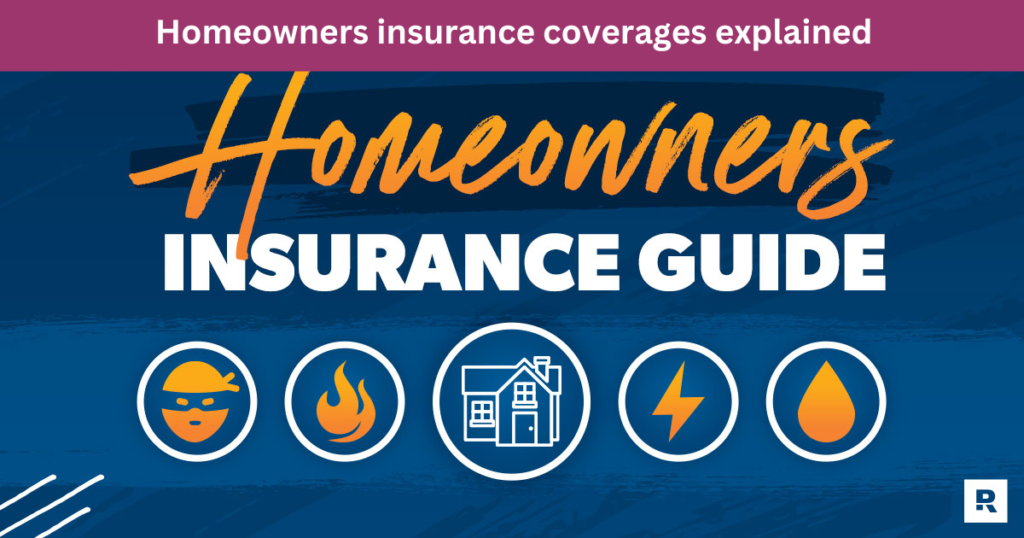Homeowners insurance is a crucial financial safeguard for homeowners, offering comprehensive coverage for your home and personal belongings in the event of unexpected events or disasters. Let’s delve into the key components of homeowners insurance.

Coverage Options homeowners insurance
Dwelling Coverage
Dwelling coverage is a fundamental component of homeowners insurance, providing financial protection for the structure of your home. If your home’s structure is damaged or destroyed by covered perils such as fire, vandalism, or natural disasters, dwelling coverage will reimburse you for the cost of repairs or rebuilding. This includes structural elements such as the walls, roof, floors, foundation, and attached structures like garages or sheds. Dwelling coverage ensures that your home can be restored to its pre-loss condition, allowing you to continue living in a safe and secure environment.
Personal Property Coverage
Personal property coverage safeguards your belongings inside your home, including furniture, electronics, clothing, appliances, and other personal items. If your belongings are stolen, damaged, or destroyed by covered events like theft, fire, or windstorm, personal property coverage will pay to repair or replace them. This coverage extends beyond the physical structure of your home to protect the items that make it a comfortable and functional living space. Whether it’s replacing a damaged sofa, repairing a water-damaged laptop, or replacing clothing destroyed in a fire, personal property coverage provides financial assistance to help you recover from losses.
Liability Coverage
Liability coverage is essential for protecting you against legal claims and lawsuits arising from injuries or property damage that occur on your property. If someone is injured on your property or if you accidentally damage someone else’s property, liability coverage will cover medical expenses, legal fees, and settlement costs associated with liability claims. This coverage provides financial security and peace of mind knowing that you’re protected against potential financial liabilities and legal proceedings. Whether it’s covering medical bills for a guest who slips and falls on your icy driveway or settling a lawsuit filed by a neighbor whose property was damaged by a fallen tree from your yard, liability coverage ensures that you’re not financially devastated by unexpected accidents or incidents.
Additional Living Expenses (ALE)
Additional Living Expenses (ALE) coverage is designed to help you cover the costs of temporary living arrangements if your home becomes uninhabitable due to a covered loss. This includes expenses such as hotel bills, rental costs, restaurant meals, and other necessities while your home is being repaired or rebuilt. Whether your home is damaged by a fire, storm, or other covered event, ALE coverage ensures that you and your family can maintain a comfortable standard of living during a challenging time. It provides peace of mind knowing that you have financial assistance to cover the additional expenses of temporary housing and living arrangements until you can return to your home.
Additional Benefits homeowners insurance
Personal Liability Umbrella: This is an additional layer of liability insurance that goes beyond the limits of your standard homeowners insurance policy. Homeowners insurance typically includes liability coverage, which helps protect you financially if you’re found legally responsible for injuring someone or damaging their property. However, these policies often have limits on how much they will pay out. A personal liability umbrella policy increases that coverage limit, providing extra protection in case you’re faced with a major lawsuit or claim that exceeds your standard policy’s limits. It helps safeguard your assets and future income from being at risk in the event of a costly legal judgment against you.
Scheduled Personal Property: Standard homeowners insurance policies usually include coverage for personal belongings such as furniture and clothing, but they often have limits on high-value items like jewelry, art, or collectibles. Scheduled personal property insurance allows you to specifically list these high-value items and insure them for their full appraised value. This specialized coverage ensures that if these items are lost, stolen, or damaged, you can be compensated for their true worth, rather than being limited by the standard coverage limits of your homeowners policy. It’s a way to protect your most valuable possessions with tailored insurance coverage.

Flood Insurance: While homeowners insurance provides coverage for many types of damages, it typically does not cover floods. Flood insurance is a separate policy that protects your home and its contents from damages caused by flooding, which can result from various sources such as heavy rainfall, overflowing rivers, or storm surges. Since flood damage can be catastrophic and costly to repair, especially in areas prone to flooding, having flood insurance can provide financial security and peace of mind. It helps cover the costs of repairing or rebuilding your home and replacing belongings damaged by floods, filling the gap left by standard homeowners insurance policies.
How to Obtain Homeowners Insurance homeowners insurance
- Research:
- Start by researching different insurance providers and their homeowners insurance offerings. Look for reputable companies with a history of financial stability and good customer service.
- Consider factors such as coverage options, premiums, deductibles, and customer reviews. Determine what types of coverage are important to you, whether it’s standard coverage for your home and belongings, or additional options like flood insurance or personal liability umbrella policies.
- Request Quotes:
- Contact insurance companies directly or use online quote comparison tools to request quotes based on your home’s details and coverage preferences. Provide accurate information about your home’s location, size, age, construction materials, and any unique features or risks.
- Be prepared to answer questions about your desired coverage limits, deductible amounts, and any additional coverages you’re interested in.
- Compare Policies:
- Review the quotes received from various insurance providers, comparing factors such as coverage limits, deductibles, exclusions, and premiums.
- Consider not only the cost of the policy but also the level of coverage provided and any additional benefits or discounts offered by each provider.
- Read the Fine Print:
- Once you’ve narrowed down your options, carefully review the policy documents provided by each insurance company.
- Pay close attention to the coverage terms, exclusions, and conditions outlined in the policy. Look for details such as coverage limits, deductibles, and any endorsements or additional coverages included in the policy.
- Make sure you understand what is covered and what is not, as well as any limitations or restrictions that may apply.
- Purchase the Policy:
- Once you’ve selected a homeowners insurance policy that meets your needs and budget, it’s time to purchase the policy.
- Provide accurate information about your home and any additional coverages you require to ensure coverage eligibility.
- Work with the insurance company to finalize the details of your policy and arrange for payment of premiums.
- Keep copies of all policy documents for your records, and make sure you understand how to contact your insurance provider in case of emergencies or questions about your coverage.
Please Read More: Term life insurance quotes without personal information
Please Read More: Travel insurance for usa for senior citizens
Conclusion
I hope that you would have liked some other posts. Friend, if you liked this post, then you must like this post and share it with your friends. I know that you would have liked the given information very much. If you are related to this question, If you have any questions, please leave a leave a comment.
